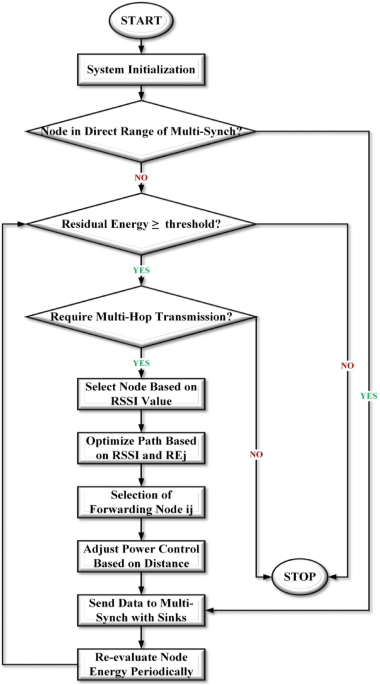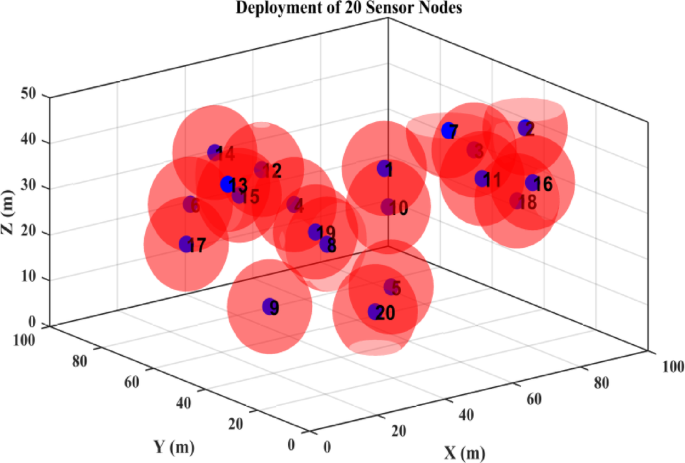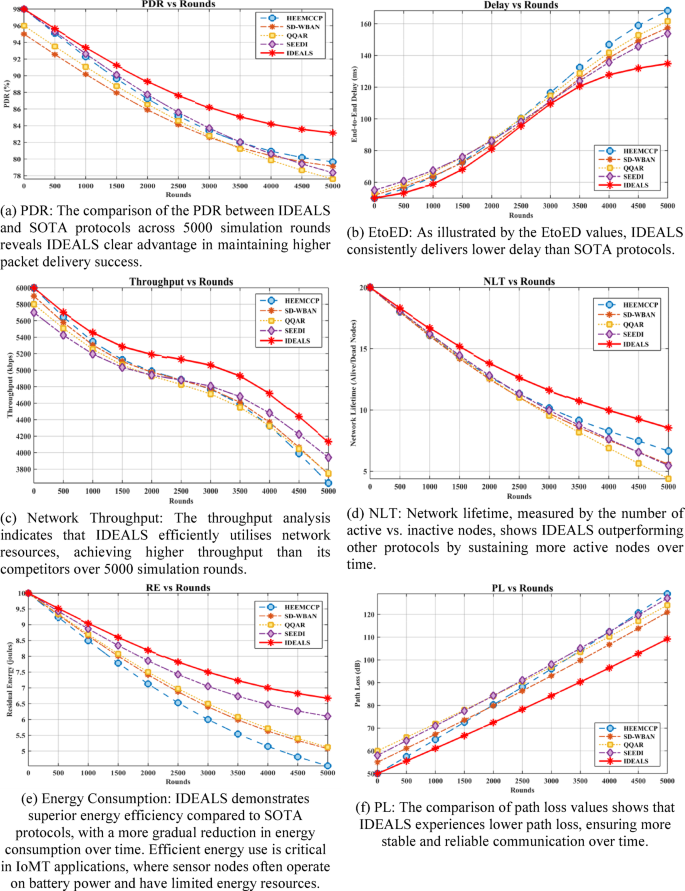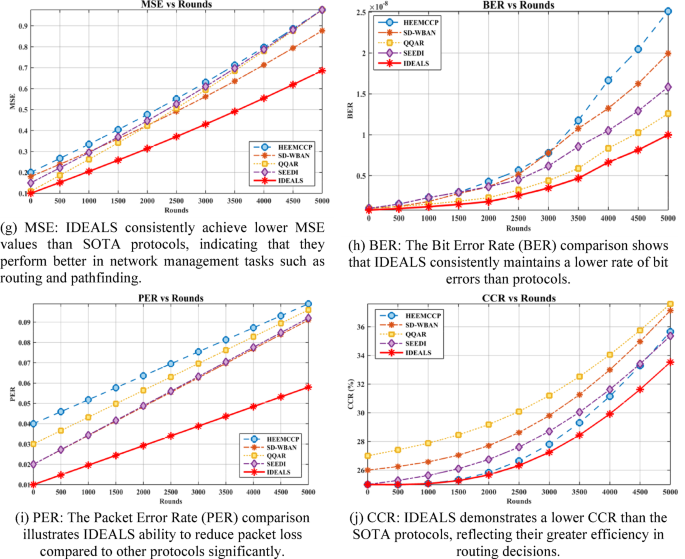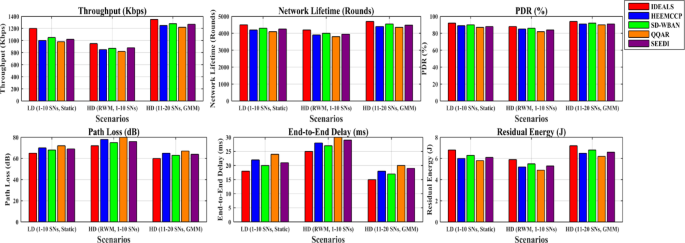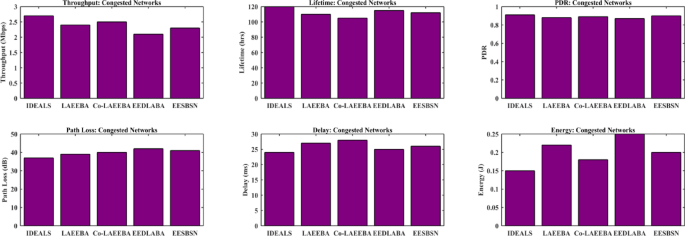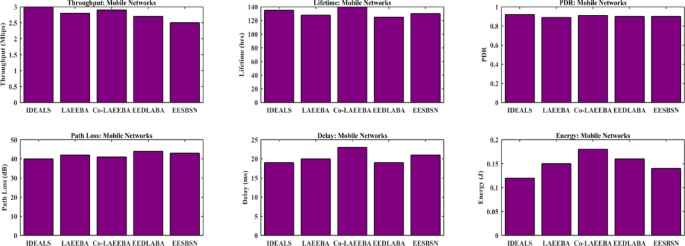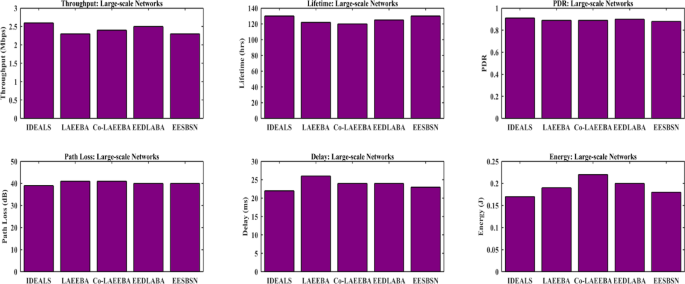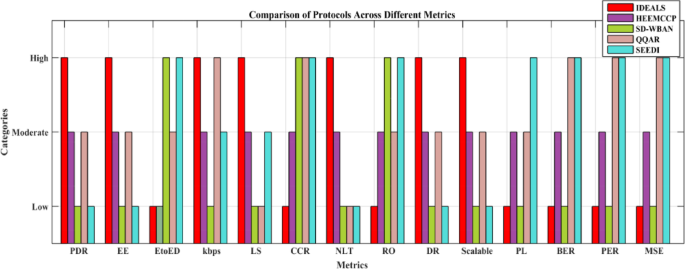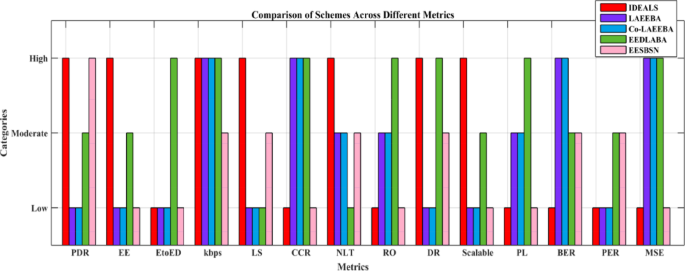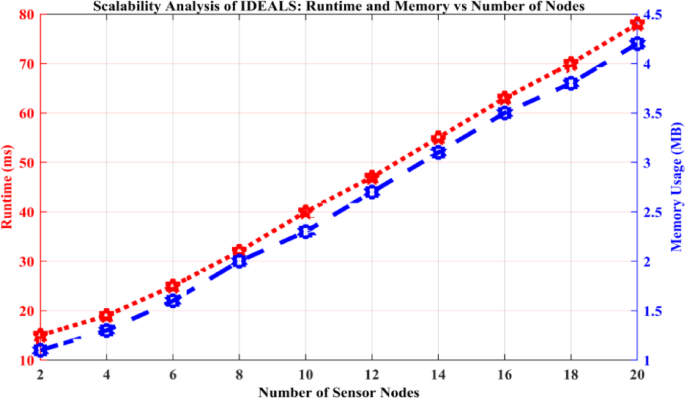In this section, we discuss the performance of the IDEALS, which is designed for IoMT applications. The simulation results and metric analysis provided are based on the performance of five protocols, HEEMCCP, SD-WBAN, QQAR, SEEDI, and IDEALS, in terms of PDR, EtoED, Throughput, NLT, RE, PL, MSE, BER, PER, and CCR. Figure 2 shows the proposed network model for sensor node deployment in IoMT, while Table 1 shows the parameters with their values taken for simulations, along with the performance evaluation metrics that have been undertaken.
Node Deployment Scenario and Coverage Area (visual representation of the deployment scenario of the nodes within the proposed network’s spatial volume and size). It effectively captures how nodes are distributed in a three-dimensional space, specifically within a 100 m x 100 m x 50 m³ volume, clearly depicting the networks physical layout. Each node is depicted with its corresponding coverage area, highlighting the range within which it can communicate and interact with other nodes in the network.
The 3D deployment of the nodes emphasises the real-world application of the network, where physical constraints such as distance, obstacles, and environmental factors influence node positioning and communication efficiency. This spatial representation helps to visualise how the network operates in a real-world scenario, where nodes are strategically placed to ensure optimal coverage and minimise communication gaps. By illustrating the coverage area for each node, the Figure emphasises the extent to which each node can serve and connect with its surrounding environment, ensuring continuous and reliable communication. The 3D arrangement of the nodes underscores the complex nature of network design in real-world IoMT applications, where factors like node density, placement, and coverage are critical to ensuring seamless data transmission and network stability. Overall, this Figure offers a detailed, spatial perspective of the network deployment strategy, providing a clear understanding of how the proposed system functions in three-dimensional space to maximise coverage and network efficiency.
Table 1 General simulation Parameters, their Values, Ranges, and Description.Reliability evaluation
IDEALS maintains a high PDR by adjusting routes based on real-time conditions like bandwidth and signal strength. This adaptability ensures reliable delivery, particularly for urgent applications like telemedicine. Figure 3(a) compares IDEALS to other leading protocols. Furthermore, IDEALS keeps MSE low through error correction techniques like retransmission, ensuring accurate data delivery. This is particularly important for sensitive applications such as healthcare. Figure 3(g) compares the MSE of IDEALS with other protocols. IDEALS reduces BER by adjusting transmission power and using error correction techniques. This is critical in healthcare, where data accuracy is essential. Figure 3(h) shows how IDEALS compares to other methods in terms of BER. IDEALS minimizes PER by selecting optimal routes and retransmitting lost or corrupted packets. This ensures reliable data delivery, which is crucial in fields like healthcare. Figure 3(i) compares PER for IDEALS and other schemes.
Performance Evaluation of IDEALS against other Protocols: PDR, EtoED, Throughput, NLT, Energy Consumption, PL, MSE, BER, PER, CCR.
Energy efficiency evaluation
IDEALS enhances NLT by using energy-efficient algorithms, balancing load, and adjusting power consumption based on node distance. It also considers node energy levels when selecting routes, preventing early failures. IDEALS significantly increase NLT compared to other protocols, which is essential in critical applications like healthcare. Figure 3(d) illustrates IDEALS superior performance in NLT. Table 2 illustrates the performance of NL in terms of alive/dead nodes. The total simulation rounds are 5000, and the total number of nodes is 20, which means these are multiplied to find each scheme’s overall operational time in terms of alive and dead nodes.
$${5000_{Rounds}} \times {20_{Nodes}}=100,{000_{tota{l_{NLT}}}}$$
(28)
This represents the number of node-simulation interactions (i.e., 20 nodes are involved across 5000 rounds). Based on this, we can generate a value representing the performance for all nodes over the simulation rounds. Now, we can calculate an aggregated value for each protocol by considering the following. We calculate an average or a combined value for each round for each FND, HND, and LND protocol. Multiply this aggregated value by the total node-simulation pairs (100,000) to get a total performance score for each protocol. The FND, HND, and LND values at each simulation round will be used to calculate the average for each protocol. We can now compute this for each protocol regarding average FND, HND, and LND over the 10 entries (simulation rounds).
$$\begin{gathered} Average~Valu{e_{\left( {per~protocol} \right)}}=\frac{{Sum~of~FND~values}}{{10}}+ \hfill \\ \frac{{Sum~of~HND~values}}{{10}}+~~\frac{{Sum~of~LND~values}}{{10}} \hfill \\ \end{gathered}$$
(29)
Finally, multiply each average value by 100,000 to get the total performance value for each protocol.
Table 2 Network lifetime (NLT) and performance analysis for all protocols (it displays the network lifetime (NLT) scenario for all schemes in terms of FND, HND, and LND. It also includes the average calculations for each scheme and their corresponding total performance scores. The performance scores are derived by calculating the average values of FND, HND, and LND for each protocol across the simulation rounds and multiplying these averages by the total number of node-simulation interactions.
The exceeding values denote that the protocols have the highest operational time. In this sense, IDEALS has the highest operational time during the entire simulation. It also indicates that the death of FND, HND, and LND has recently occurred in IDEALS, in contrast to other schemes where node death occurs more rapidly. Furthermore, IDEALS optimises energy use by selecting shorter paths, adjusting power levels, and evenly distributing energy consumption across nodes. This approach extends network life, especially in critical areas like healthcare monitoring. Figure 3(e) compares RE performance across different protocols. IDEALS optimises CCR by using simple, efficient, lightweight routing algorithms and adapting to network changes without heavy computation. This reduces the load on nodes, ensuring smooth operation without draining resources. Figure 3(j) compares the CCR of IDEALS with other schemes.
Delay and throughput evaluation
IDEALS reduces EtoED by selecting shorter, less congested routes and adjusting in real-time. Unlike fixed-path protocols, IDEALS adapts to network changes, ensuring timely telemedicine and emergency care data deliveryshown in Fig. 3(a). Figure 3(b) compares EtoED for IDEALS versus other methods. Furthermore, IDEALS optimises throughput by selecting routes with less traffic and adjusting data rates based on network conditions. Its real-time adjustments help maintain throughput even in high-demand environments, making it ideal for busy networks. Figure 3(c) compares IDEALS’ throughput performance with other protocols. IDEALS reduces PL by selecting optimal routes and adjusting transmission power based on current conditions. Its adaptability helps maintain a strong signal, even in challenging environments, ensuring reliable communication. Figure 3(f) compares PL for IDEALS and other methods, in Fig. 3 shown the Performance Evaluation of IDEALS against other Protocols. Table 3 shows the overall performance of IDEALS vs. SOTA schemes.
Table 3 Performance Summary of IDEALS vs. SOTA Schemes (here presents the performance comparison between IDEALS and SOTA schemes, highlighting the overall percentage improvements of IDEALS across each metric). The improvements are calculated based on the relative performance enhancements of IDEALS compared to the existing protocols, providing a clear view of how IDEALS outperforms other schemes in various network performance indicators.
The IDEALS protocol is implemented in MATLAB, and nodes are deployed in a 100 × 100 × 50 m³ healthcare monitoring space. We evaluated two mobility models: the GMM model for correlated movements, mimicking wearable devices on patients, and the RWM model for unpredictable mobility, simulating mobile health units. The network included 1–10 and 11–20 Sensor Nodes (SNs), with data rates of 10–50 Kbps and packet sizes of 100 bytes to 1 KB, representing real-time IoMT applications. Sampling rates varied from 1 to 10 Hz, and transmission intervals ranged from 1 to 10 s. Both static and dynamic scenarios were tested to assess performance in varying movement conditions. IDEALSS effectively enhances network lifetime, throughput, and path loss reduction from these analyses and assessments, ensuring reliable healthcare communication in diverse deployment scenarios. To evaluate the adaptability of IDEALS, we conducted simulations under varying mobility models and node densities, comparing them against HEEMCCP, SD-WBAN, QQAR, and SEEDI. The simulation incorporated different node groups (1–10 and 11–20 nodes) to evaluate performance across low and high-density deployments. We have implemented two mobility models to evaluate IDEALS under different movement conditions. GMM model is simulated for wearable devices on patients with tuning parameter α = 0.75, high correlation for smooth mobility, and node speed of 0.1–1.5 m/s (low-speed mobility reflecting real-world patient movement). The RWM model simulates unpredictable movements, such as mobile health units or roaming patients, with a node speed of 0.5–2 m/s (random speed variations) and a pause time of 0–5 s (random delays in movement). We evaluated IDEALS with different network sizes, such as Low Density (LD) of 1–10 SNs and High Density (HD) of 11–20 SNs, with a deployment area of 100 × 100 × 50 m³ (fixed for fair comparison). IDEALS were evaluated against HEEMCCP, SD-WBAN, QQAR, and SEEDI under node densities and mobility scenarios. The key performance metrics, such as LD, HD, GMM, and RWM models, are presented in Fig. 4.
The communication scenario of the simulation is presented, comparing the performance of the IDEALS scheme with SOTA protocols across multiple metrics: throughput, network lifetime (NLT), packet delivery ratio (PDR), path loss (PL), end-to-end delay (EtoED), and reliability evaluation (RE). This analysis demonstrates the effectiveness of the proposed IDEALS scheme in terms of key performance indicators in IoMT applications.
The evaluation of IDEALS was conducted against new existing schemes, LAEEBA45, Co-LAEEBA46, EEDLABA22, and EESBSN47 in terms of Large-Scale, Mobility, and Congested Networks, and under varying node densities and mobility scenarios. We’ve evaluated IDEALS with different network sizes, such as LD of 1–10 SNs and HD of 11–20 SNs, with a deployment area of 100 × 100 × 50 m³ (fixed for fair comparison). Figures 5, 6 and 7, and 8 present the key performance metrics.
This Figure further expands the communication scenario of the simulation by including additional SOTA schemes to provide a broader evaluation of IDEALS. It highlights the performance comparison across throughput, NLT, PDR, PL, EtoED, and RE metrics, emphasising the advantages of the IDEALS protocol over existing solutions in more diverse network conditions.
The simulation scenario demonstrates the performance of IDEALS and SOTA protocols in congested network conditions. The metrics include throughput, NLT, PDR, PL, EtoED, and RE, which focus on the network’s ability to handle increased load and highlight IDEALS’ superior performance in maintaining network efficiency and reliability under strain.
This Figure evaluates the IDEALS scheme in mobility networks with movable nodes in IoMT. The performance of IDEALS and SOTA protocols is compared across multiple metrics, showcasing how the system handles dynamic environments where nodes are in motion, emphasising IDEALS adaptability and robustness in real-world IoMT applications.
The simulation results in congested networks are presented, comparing the IDEALS scheme with SOTA protocols. Metrics such as throughput, NLT, PDR, PL, EtoED, and RE are assessed to evaluate how each protocol performs under network congestion conditions, with IDEALS demonstrating superior efficiency and lower resource consumption.
We employed two widely used models to model node mobility in clinical environments: the RWM and the GMM. These models help simulate a range of mobility patterns, from random movements typical of mobile monitoring devices or non-critical patients RWM, to smoother, more correlated movements observed in guided or semi-structured environments GMM. While these models provide a controlled means to assess the performance of the IDEALS protocol under varying mobility conditions, we acknowledge that they are not direct representations of real patient or staff movement in hospitals. Our current work does not utilise empirically derived mobility traces; however, the literature has shown that GMM can approximate realistic movement behaviours better than purely random models. We consider this a first-order approximation and suggest that future work incorporate real-world mobility datasets (e.g., hospital floor plans with sensor-tracked movement logs) to validate the protocol under more realistic conditions. This would strengthen the practical applicability of IDEALS in real healthcare deployments.
Table 4 The performance comparison of the IDEALS scheme against various SOTA protocols across different evaluation metrics is shown here. It categorises performance levels into low, moderate, and high, clearly Understanding how IDEALS outperforms others in specific areas of network performance.
The simulation was executed in MATLAB using a 3D network space of 100 × 100× 50m2, with 20 sensor nodes deployed. Each node transmitted data packets ranging from 100 bytes to 1 KB, with 10–50 Kbps data rates and energy capped at 10 joules per node (Figs. 9, 10). The evaluation was performed over 5000 rounds, and both GMM and RWM mobility models were used to simulate realistic and unpredictable node behavior. Figure 11 shows the scalability analysis of IDEALS with runtime and memory vs. the number of nodes deployed.
The overall performance of the IDEALS scheme is illustrated and compared with SOTA methods, highlighting its strengths across all evaluation metrics. The focus is on breaking performance into low, moderate, and high categories, demonstrating IDEALS consistent superiority in key areas.
The expands on the previous analysis by including additional SOTA methods for comparison. It highlights the performance of the IDEALS scheme across all evaluation metrics, emphasizing its low, moderate, and high-performance levels, showcasing the comprehensive advantages of IDEALS over other methods.
Discussion
In the realm of the IoMT, the demand for efficient, reliable, and energy-conscious routing protocols is ever-increasing due to the sensitivity of medical data and the energy constraints of sensor nodes. Our protocol focused on challenges caused by energy, LS, and routing to enhance energy consumption, ensure stable communication links, and improve data delivery reliability. The IDEALS were compared against HEEMCCP, SD-WBAN, QQAR, and SEEDI to assess their performance across key metrics critical to IoMT applications. One of the key findings from the evaluation is that IDEALS consistently outperforms existing protocols in several important areas, such as PDR, EE, EtoED, and Throughput. This improved performance comes from two main things: focusing on location services and being smart about energy use. IDEALS include specific ways to save energy. For example, it features distance-aware communication routes and smart power control. This keeps energy consumption low. As a result, devices can last longer without running out of battery. In the IoMT, this energy-saving feature is essential. Consider wearables such as health monitors or smart medical implants. These devices require a significant amount of power, and their energy efficiency directly impacts their lifespan.
On top of that, IDEALS does a great job with location services. It selects communication paths that are stable and change minimally. This is particularly crucial in IoMT, where data loss or delays can result in serious problems. When we compare IDEALS with other protocols, such as SEEDI, SD-WBAN, QQAR, and HEEMCCP, it has a higher packet PDR and uses less energy.
Another point is how well IDEALS manages energy use while maintaining high throughput. It shows that IDEALS can deliver data on time, which is essential for IoMT applications. The way it adapts energy use based on location services and smart routing helps maintain high PDR rates without compromising reliability or increasing energy consumption. IDEALS is doing incredible work ensuring devices last longer, stay reliable, and send data quickly without consuming energy. This is crucial in medical applications where real-time monitoring and timely data transmission are required for patient safety and diagnosis. Similarly, the CCR in IDEALS was found to be optimized compared to other protocols. IDEALS minimizes the load on the sensor nodes, which is important for energy-constrained devices operating in IoMT scenarios by focusing on minimal computational overhead and reducing the number of routing decisions required. The overall comparison of IDEALS with other schemes is shown in Table 4. The evaluation scenarios of all methods across all metrics are shown in Figs. 10 and 11. The evaluation of IDEALS against existing schemes, such as HEEMCCP, SD-WBAN, QQAR, SEEDI, LAEEBA, Co-LAEEBA, EEDLABA, and EESBSN, across all evaluated scenarios, including PDR, throughput, energy consumption (%), and residual energy (J), has shown outstanding performance. Specifically, IDEALS achieves optimal energy efficiency while maintaining high throughput and PDR, without significant trade-offs in performance. This demonstrates that IDEALS can effectively balance energy savings and other key metrics. With new simulations, we’ve further highlighted this aspect in emphasizing IDEALS’ robustness in varying healthcare contexts, ensuring reliable performance without compromising energy efficiency. Let’s break this down into simpler terms.
The scalability of the IDEALS scheme is demonstrated by analyzing its performance with up to 20 nodes. The graph shows how runtime and memory usage scale with increasing sensor nodes, providing insight into IDEALS scalability and efficiency in larger IoMT networks.
We can use some of the metrics to evaluate how well IDEALS works. These numbers include metrics such as PL, BER, PER, and MSE. Each of these tells us something important about how well IDEALS does its job compared to other systems. By lowering these numbers, IDEALS facilitates the smoother transmission of medical data in the IoMT. This is a big deal! If these numbers are lower, there is less data loss or distortion. So, when you send information about patient care, it arrives correctly. In short, IDEALS is a strong choice for healthcare. It ensures that important medical information is sent quickly and accurately. This is crucial for doctors and hospitals that need reliable data to care for their patients.
Energy-performance trade-off, reliability, comparative advantage, relevance and limitations
One of the critical goals of IDEALS is to achieve a balance between energy efficiency and communication reliability. The protocol demonstrates superior RE retention and extended NLT across all simulation rounds. This is attributed to the dual-layer synchronization and adaptive routing mechanisms that reduce redundant transmissions and enable efficient unicast/multicast communication. However, these energy-saving strategies do not compromise delay performance, as evidenced by the low EtoED results, making IDEALS suitable for time-sensitive medical applications. IDEALS outperforms existing methods in terms of PDR, ensuring reliable data delivery even in the presence of node mobility and dynamic signal conditions. Its integration of RSSI thresholds and PL-aware routing allows it to maintain stable links, effectively mitigating packet drops and disconnections common in body-centric networks. This resilience is critical in real-time health monitoring scenarios, where continuous and accurate data delivery is paramount. Unlike CRPBA and HCEL, which suffer from higher delays due to limited path diversity, or WHOOPH and TSFIS-GWO, which exhibit energy inefficiency under dense node deployment, IDEALS incorporates a hybrid communication model with direct and multi-hop modes. It dynamically switches routes based on link quality and energy status, offering flexibility and robustness.
Furthermore, its synchronization model minimizes idle listening and overhearing, reducing protocol overhead compared to conventional MAC-based schemes. The enhanced performance of IDEALS across all evaluated metrics underlines its applicability in various real-world IoMT use cases, such as remote patient monitoring, emergency response systems, and immersive telehealth in metaverse-based healthcare systems. Its design aligns with the operational requirements of low-latency, energy-efficient, and highly reliable communication, which are critical in clinical settings. While the simulation environment validates the protocol’s efficiency, real-world deployments may present additional challenges such as unpredictable mobility patterns, interference from other wireless systems, and variations in human physiology. Future research will focus on implementing IDEALS on hardware testbeds with wearable devices and incorporating AI-based prediction models to enhance route stability and adaptivity in real-time.
Statistical validation of results
We’ve integrated statistical analysis to validate the performance improvements reported for our proposed IDEALS protocol compared to existing SOTA approaches. All evaluations were conducted via simulation, and to ensure robustness and reliability, we executed each simulation scenario 30 independent times using randomized initial conditions and varying sources. For key performance metrics, including PDR, NLT, RE, and BER, we report the mean, standard deviation, and paired t-test p-values. These statistical measures allow us to assess whether the observed performance differences between IDEALS and competing protocols are statistically significant or due to random variations. Table 5 presents the results of this statistical validation. We report the mean and standard deviation over 30 runs for each metric and method. The p-values from paired t-tests compare IDEALS against each baseline method, testing the null hypothesis that there is no significant difference in performance. Across all metrics and baselines, the p-values are well below 0.05, indicating that the performance improvements of IDEALS are statistically significant with 95% confidence. For example, in PDR, the IDEALS outperforms HEEMCCP (p ≈ 7.61e-22), SDWBAN (p ≈ 4.56e-24), QQAR (p ≈ 3.41e-28), and SEEDI (p ≈ 2.18e-26). In NLT, the IDEALS yields statistically longer node lifetimes than HEEMCCP (p ≈ 1.52e-25) and other SOTA protocols. Similar significance levels are observed in RE and BER, confirming that IDEALS conserves energy better and maintains more reliable transmission. These results underscore that IDEALS’s performance benefits are consistent across multiple runs and statistically validated.
Table 5 This table presents a statistical comparison of the IDEALS scheme against SOTA protocols across key performance metrics. The comparison is based on 30 simulation runs, providing a robust evaluation of each protocol’s performance consistency and reliability across multiple iterations.Justification of baseline selection
The protocols included in our comparison, HEEMCCP, SD-WBAN, QQAR, SEEDI, LAEEBA, Co-LAEEBA, EEDLABA, and EESBSN, were carefully selected based on several key criteria. First, relevance to WBANs was a critical factor. All the selected protocols were specifically designed for WBANs or closely related low-power, short-range IoT environments, making them directly applicable to the context of the IDEALS protocol. Second, selecting these protocols reflects their representation of key routing strategies. For instance, energy-aware routing was emphasized by protocols such as HEEMCCP, EEDLABA, and EESBSN, all of which focus on conserving energy in resource-constrained networks. Additionally, SEEDI and QQAR, prioritizing reliable transmission and QoS, represented link-quality-based approaches. Protocols like SD-WBAN, LAEEBA, and Co-LAEEBA incorporate distance or topology-aware designs, optimizing communication efficiency based on spatial awareness. Lastly, protocols such as Co-LAEEBA and SEEDI utilized hybrid or composite metrics, which combine multiple factors, though they do not employ dynamic or adaptive weighting. Third, the selected protocols’ competitiveness in WBAN and energy-efficient IoT routing was also decisive. These protocols have been frequently cited in recent literature and are widely recognized as strong baseline approaches. For example, HEEMCCP and Co-LAEEBA are among the most benchmarked energy-efficient routing schemes in recent comparative studies.
Emphasis on IDEALS’ unique improvements IDEALS
To highlight the distinct contributions of IDEALS beyond its numerical improvements, we focus on the following key differentiators. First, unified multi-metric routing is a unique feature of IDEALS. While most baseline protocols optimize a subset of factors, IDEALS integrate distance, residual energy, and link stability into a single normalized, adaptive metric. This approach allows for a more comprehensive and efficient decision-making process. Second, context-aware adaptivity sets IDEALS apart from static-weight schemes. Unlike traditional methods that rely on fixed weights, IDEALS dynamically adjusts metric weights based on runtime network conditions, ensuring more resilient and efficient routing in various scenarios. This adaptability allows IDEALS to perform optimally across varying network topologies and conditions. Finally, IDEALS offers cross-layer awareness, a feature not in the baseline protocols. By leveraging MAC/PHY-layer information, such as signal strength and error rate, IDEALS enhances link stability estimation, improving its routing decisions. This layer-aware approach gives IDEALS a significant advantage over traditional protocols, which typically operate without incorporating such detailed information. Based on the simulation results of the IDEALS protocol for IoMT compared to other SOTA protocols, we can compute the mean and standard deviation (± std) of IDEALS’ improvements in each metric. Table 6 provides a detailed justification for the impact and interplay between each metric in healthcare IoT.
Table 6 Presents the mean (%) & ± STD summary of the improvements achieved by IDEALS compared to SOTA protocols. It highlights the variability and consistency of IDEALS’ performance across key metrics, providing insight into the robustness of its improvements over the baseline protocols.Impact and interdependence of each metric in IoMT
The proposed IDEALS protocol introduces a synergistic routing mechanism tailored for the IoMT, where reliability, latency, energy efficiency, and resilience to mobility-induced dynamics are paramount. The following analysis details the interrelationship between key performance metrics and the rationale behind the performance superiority of IDEALS. The PDR is a critical metric for measuring data reliability, particularly in healthcare settings where data loss can directly impact patient safety. An elevated PDR signifies the successful transmission of medical data across the network. PDR inherently depends on lower BER and PER, since reduced bit or packet corruption enhances overall delivery success. PDR also benefits from increased link stability and minimized path loss, ensuring sustained and interference-resilient transmission. The IDEALS protocol leverages dynamic, energy-aware link selection and predictive stability algorithms to maintain high PDR under varying conditions. Low latency is essential for real-time healthcare applications such as remotely monitoring cardiac signals or insulin levels. End-to-End Delay reflects the time a data packet travels from source to destination. A reduced EtoED contributes to increased PDR and improved CCR, ensuring timely and accurate decision-making at the sink or medical data server. However, optimizing delay must be balanced with energy constraints, as faster transmissions can incur higher energy costs. IDEALS achieves this trade-off effectively by utilizing proactive route selection and early detection of potential link failures to prevent retransmissions and timeouts. Throughput indicates the rate at which useful medical data is transmitted across the network, which is vital for applications such as streaming biosignals or transmitting large diagnostic files. Throughput improves when the network maintains high PDR, efficient energy usage, and reduced BER. Moreover, reduced path loss enhances signal strength, contributing to throughput improvements. IDEALS enhances throughput through intelligent load balancing and adaptive routing, prioritizing bandwidth-efficient paths with high link quality. Maximizing network lifetime is crucial in IoMT, where many sensor nodes are battery-powered and not easily replaceable in clinical or remote settings. Network lifetime reflects the duration for which the majority of nodes remain operational. NLT is closely linked to residual energy levels and the overall efficiency of energy consumption strategies. Lower end-to-end delays and reduced retransmissions conserve battery life. IDEALS extends network longevity by ensuring balanced energy consumption among nodes, thereby preventing early node depletion and maintaining network connectivity. Residual energy quantifies the remaining battery power of sensor nodes. High residual energy across the network implies efficient energy utilization and longer operational periods. Higher RE supports longer network lifetime and contributes to consistent data delivery and classification accuracy. The IDEALS protocol incorporates energy-aware metric weighting and avoids overburdening specific nodes (especially central nodes), thereby maintaining uniform energy expenditure across the network. Path Loss measures the attenuation of signal power during transmission. High path loss leads to signal degradation, packet loss, and elevated BER. Lower PL correlates with enhanced PDR, improved throughput, and energy efficiency, as fewer retransmissions are needed and signal integrity is preserved. IDEALS reduces PL by dynamically selecting routes with favorable propagation conditions, especially in mobile and indoor healthcare environments where signal obstructions are common. MSE serves as a measure of prediction accuracy in modeling link stability or signal behavior. Lower MSE indicates better predictive capability and signal estimation. Inaccurate predictions (high MSE) result in misrouting, increased retransmissions, and ultimately higher BER and PER. IDEALS minimizes MSE and enhances network responsiveness to mobility and interference by integrating machine learning-style filtering for link stability estimation. The BER indicates the frequency of bit-level transmission errors, which directly impacts the integrity of medical data. High BER leads to elevated packet error rates and reduced PDR, which may trigger retransmissions and longer delays. IDEALS maintains low BER by selecting routes with high Signal-to-Noise Ratio (SNR), improving reliability even in dynamically changing environments. PER reflects the proportion of packets that are received incorrectly. High PER undermines overall network reliability and throughput. Lower PER is a direct consequence of reduced BER and effective interference management. The IDEALS protocol minimizes PER by incorporating stability-based routing and employing interference-aware link selection to avoid congested or noisy channels. CCR represents the protocol’s ability to correctly route and interpret network states, including node roles, anomalous conditions, or mobility patterns. In intelligent healthcare networks, CCR influences service quality, context-aware decision-making, and routing cost regarding workloads. Higher CCR is associated with improved security posture, lower MSE, and efficient routing decisions that avoid unnecessary data transmissions. IDEALS incorporates context-aware, decision-fusion algorithms that enhance CCR, making it well-suited for real-time, adaptive healthcare environments.
